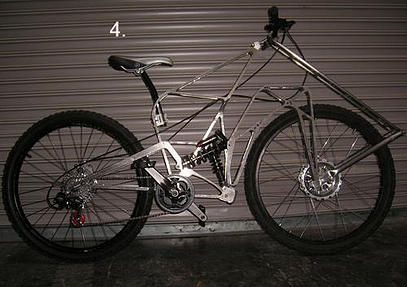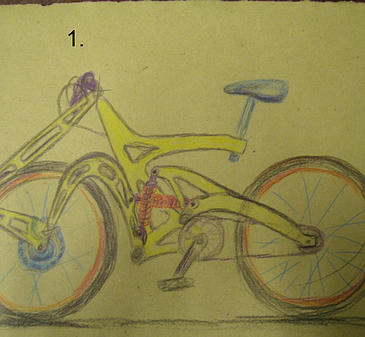The elegance of beauty, form, and function?

Claiming innovations in the areas of continuously-variable transmissions, two-stroke engines, and bicycle suspension, Raer Design’s portfolio is certainly a broad one. First conceived in 1991, the firm’s Directly Connected Suspension was born of the desire to avoid what is being called ‘pitch’. The distinctive crossed shocks are each connected primarily to one wheel… and secondarily to the other. The intent is to raise the front end when the rear is compressed and vice versa, keeping the bike and rider level on varying terrain. Beyond running counter to this explanation, a statement that rear braking compresses the front suspension is of some concern, given that brake jack is something many have worked very hard to avoid.

Originally envisioned for motocross use, Directly Connected Suspension is also said to have the (unintended) effect of minimising pedal bob – a good thing given the latest version’s high rear suspension pivot – improving pedaling efficiency as a result.

For those looking for more detail, the Raer’s discussion on the theory behind the Directly Connected Suspension design is fascinating.





Muddy Fox Rock N Roll…
(I think that was the one from the 90s with the connected suspension). More fluoro though.
If you go round a corner, does the front linkage hit you knees?
Why?
Most bicycle suspension systems work well enough around the up/down forks, bit in the middle, up/down back end. Not perfect, some work better than others, but a pretty good compromise all round.
….and what the hell happens when you try to jump something?
Sometimes designers get caught up trying to design out a problem that other people have already designed out in another way, or moved away from.
Case in point is 29ers… Many 29er designers spent a long time trying to get “quick handling like 26ers”, but whilst the 29er people were doing that, the 26er people suddenly realised they wanted more stable slacker slower handling. As a result 29ers got all confused and tarred with the wrong brush. Or something.
Suspension performance, with dual link, single pivot, single chainring, double chainring, and all that sort of stuff is really quite settled down now, and this seems a wonderful technological proof of concept, it’s hard to see how it would work on the trail. And yes, surely the front linkage would hit your knees.
Muddy Fox Intereactive
Luckily, because us humans are much heavier than our bikes, and are principally attached by the cranks,which by their very nature must rotate in the frame, “removing” pitching forces from a bicycle is both pointless and add massive compromise to the rest of the bike (like low strength, low stiffness, high weight etc) So, on a bike, where we manage “weight transfer” by just moving the 80kg sack of spuds riding the bike around, why you would want front rear interconnect baffles me.
“moving the 80kg sack of spuds riding the bike around”
LOL
Knee Killer!!!
80kg! I wish
Didn’t Whyte make something similar? PRST1?
http://fcdn.mtbr.com/attachments/custom-builders-other-manufacturers/388787d1220262060-any-whyte-prst-1-4-owners-out-there-fjy_0550.jpg
Youch! My eyyeesss!
And I thought the Whyte PRST1 was an assault on the retina!
Can’t help thinking, they’re desperately trying to design a solution to a non existent problem, and surely they don’t expect to sell many. Mind you there are plenty of eccentrics who’d probably be up for one.
When a PRST-1 and a Jones mate.
PRST-1, worst flipping bike I have ever had the misfortune of owning’ ever. Chuck D was right, don’t believe the hype!!
Oh and I wouldn’t like to clean it after a muddy one!